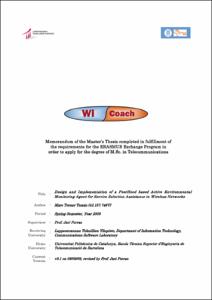Mostra el registre d'ítem simple
Design and Implementation of a PeerHood based Active Environmental Monitoring Agent for Service Selection Assistance in Wireless Networks
| dc.contributor | Porras, Jari |
| dc.contributor.author | Torner Tomas, Marc |
| dc.date.accessioned | 2010-01-19T08:04:22Z |
| dc.date.available | 2010-01-19T08:04:22Z |
| dc.date.issued | 2009 |
| dc.identifier.uri | http://hdl.handle.net/2099.1/8390 |
| dc.description | Projecte fet en col.laboració amb Lappeenrannan Teknillien Yliopisto, Department of Information Technology, Communications Software Laboratory. |
| dc.description.abstract | This project was born to cover a specific aspect of the wireless networks related to the service delivery considering a generic taxonomy where different agents can exhibit a heterogeneous offer of services and, at the same time, clients may be interested in different activities at the same time. In this scope, the need of a common way of interaction between clients and servers can be perceived to overcome the probable lack of generality in this whole picture. Two main objectives where defined and prosecuted in order to plant the first stone in the definition of a protocol to support a fair, transparent and effective service selection in wireless scenarios. First, the determination of a generic way of characterizing the different services therefore deriving to a template based descriptive object. Second, the implementation of a mechanism capable of using this format of description in order to inform the client about the best option to chose at any given moment. Following the first general objective, a series of analytical studies in terms of the parameters that could be used to describe a service where performed using as test examples Printing, Image Recognition and File Sharing services. The major efforts were done in the appliance of three discriminative patterns regarding how general or specific, static or variant and the type of limitation (maximum or minimum) each parameter is. The principle conclusions of these studies were the following. First, an important group of parameters were common to the different services under study. Second, the existence of a trade-off between the precision of the characterization (via more contextual parameters) and the homogenization of the descriptive set of parameters. Finally, each parameter could be expressed using the pair formed by the offered and demanded values. In the second place, a local agent supported by the PeerHood middleware designed to run on the client’s machine was defined and implemented in C++. This agent, known as 3WAServer, is intended to act as an active environmental monitor to assist the client’s applications in the service selection process. The bases of this assistance rely on the definition of a profile describing mainly the client’s requirements and a template containing the server’s offer. Using that information, the 3WA-Server is able to rate each particular service to provide each application with a numerical and normalized value between 0 and 1 where 0.5 or higher means complete fulfillment of the requirements. Based on these grades, the application is in position of performing a solid decision concerning the next server provider to select. The assignation of the grade to each service relies on three layer neural network balanced with a set of weights specified by the application according to its particular requirements. The network is fed with the profile and the template associated to the application acting as a client and the service provided by a particular server respectively. An experiment was set and executed in order to get a first and introductory estimation of the validity of the 3WA-Server as a service selection assistant. The experiment consisted in the deployment of two servers offering the same two services and a client moving from one to the other. This client was running local services as well. The results of the experiment pointed out that, first, the delays associated to the transmission of the parameters describing the service offered by the server were more than tolerable. Secondly, the management and execution of the neural network were proven to be effective and low resource demanding. Finally, the grading system and the proactive interaction between the local applications and the 3WA-Server suggested an expected behavior in terms of proper event generation and result notification. Nonetheless, this approach stands for a very first simulation, hence, further study and exhaustive revision are to be done. |
| dc.language.iso | eng |
| dc.publisher | Universitat Politècnica de Catalunya |
| dc.rights | Attribution-NonCommercial-NoDerivs 3.0 Spain |
| dc.rights.uri | http://creativecommons.org/licenses/by-nc-nd/3.0/es/ |
| dc.subject | Àrees temàtiques de la UPC::Enginyeria de la telecomunicació::Processament del senyal |
| dc.subject.lcsh | Wireless communication systems |
| dc.subject.lcsh | Peer-to-peer architecture (Computer networks) |
| dc.title | Design and Implementation of a PeerHood based Active Environmental Monitoring Agent for Service Selection Assistance in Wireless Networks |
| dc.title.alternative | WiCoach Project (Active Environmental Monitoring Agent for Service Selection Assistance in Wireless Networks) |
| dc.type | Master thesis (pre-Bologna period) |
| dc.subject.lemac | Comunicació sense fil, Sistemes de |
| dc.subject.lemac | Xarxes punt a punt (Xarxes d'ordinadors) |
| dc.rights.access | Open Access |
| dc.audience.educationlevel | Estudis de primer/segon cicle |
| dc.audience.mediator | Escola Tècnica Superior d'Enginyeria de Telecomunicació de Barcelona |
| dc.audience.degree | ENGINYERIA DE TELECOMUNICACIÓ (Pla 1992) |


